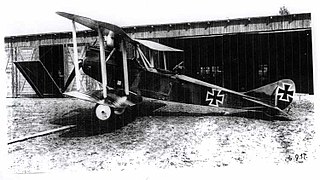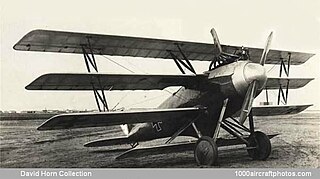Related Research Articles

The Pfalz D.III was a fighter aircraft used by the Luftstreitkräfte during the First World War. The D.III was the first major original design from Pfalz Flugzeugwerke. Though generally considered inferior to contemporary Albatros and Fokker fighters, the D.III was widely used by the Jagdstaffeln from late 1917 to mid-1918. It continued to serve as a training aircraft until the end of the war.

The LVG C.VI was a German two-seat reconnaissance and artillery spotting aircraft used during World War I.

The Gotha G.IV was a heavy bomber used by the Luftstreitkräfte during World War I. It was the first mass-produced large airplane.

The Rumpler C.IV was a German single-engine, two-seat reconnaissance biplane. It was a development of C.III with different tail surfaces and using a Mercedes D.IVa engine in place of the C.III's Benz Bz.IV. The Rumpler 6B 2 was a single-seat floatplane fighter variant with a 120 kW (160 hp) Mercedes D.III engine built for the Kaiserliche Marine.

The DFW C.IV, DFW C.V, DFW C.VI, and DFW F37 were a family of German reconnaissance aircraft first used in 1916 in World War I. They were conventionally configured biplanes with unequal-span unstaggered wings and seating for the pilot and observer in tandem, open cockpits. Like the DFW C.II before them, these aircraft seated the gunner to the rear and armed him with a machine gun on a ring mount. Compared to preceding B- and C-class designs by DFW, however, the aerodynamics of the fuselage were more refined, and when coupled with more powerful engines, resulted in a machine with excellent performance.

The LFG Roland D.II was a German single-seat fighter of World War I. The type was manufactured by Luftfahrzeug Gesellschaft, and also by Pfalz Flugzeugwerke under license.

The LVG E.I was a German two-seat monoplane of World War I. The E.I was unusual among monoplanes of its time in that it featured ailerons as opposed to the then-conventional wing warping.

The LFG Roland D.I was a fighter aircraft produced in Germany during World War I. It was a single-seat aircraft based originally on the Roland C.II two-seat reconnaissance type. It shared its predecessor's unusual design feature of having a deep fuselage that completely filled the interplane gap, but in comparison, the fuselage was much sleeker. While the C.II's appearance had earned the Walfisch ("Whale"), the D.I became known as the Haifisch ("Shark"). The I-struts that had been used to brace the C.II's wing were replaced by more conventional struts. Other changes to the wing included the removal of stagger from the design and the introduction of slight sweepback.

The LVG C.V was a reconnaissance aircraft produced in large numbers in Germany during World War I.

The Naglo D.II was a German single seat quadruplane fighter, flown late in World War I. It took part in one of the fighter competitions but did not reach production.
The Pfalz D.VI was a German sesquiplane fighter aircraft from World War I. It was not put into production.

The LVG G.III was a large, twin engine triplane bomber built in Germany near the end of World War I. Only one was completed.
The Schütte-Lanz D.VI was a single engine, parasol wing fighter aircraft designed and built in Germany towards the end of World War I. It had a very short career, crashing on its first flight.
The Schütte-Lanz D.VII was a single engine, biplane fighter aircraft designed and built in Germany towards the end of World War I.

The Naglo D.I was a German single seat quadruplane fighter, flown late in World War I. It took part in one of the fighter competitions but did not reach production.
The LVG C.VIII was a prototype reconnaissance aircraft built in Germany during World War I.
The LVG D.III was a German fighter plane built by LVG in World War I.
The LVG D.IV was a German fighter plane built by LVG in World War I.
The LVG D.V was a prototype German biplane fighter built by LVG in World War I.
The LVG D.VI was a prototype German biplane fighter built by LVG in World War I.
References
- 1 2 Gray, Peter; Thetford, Owen (1970). German Aircraft of the First World War (2nd ed.). London: Putnam. p. 479. ISBN 0-370-00103-6.
- 1 2 Rickard, John (2014-08-27). "LVG D.II". www.historyofwar.org. Archived from the original on 2019-02-01. Retrieved 2019-02-01.